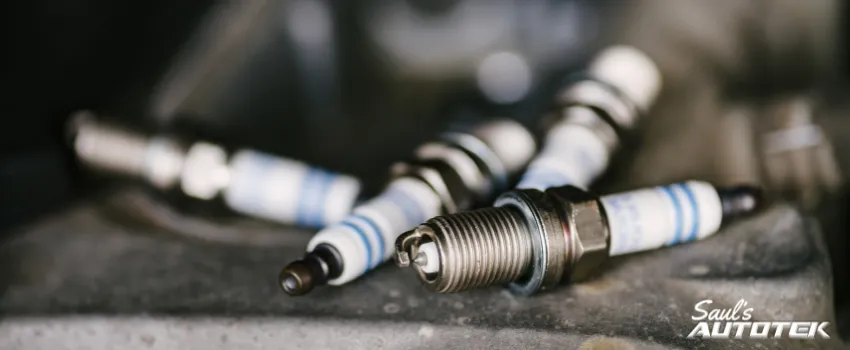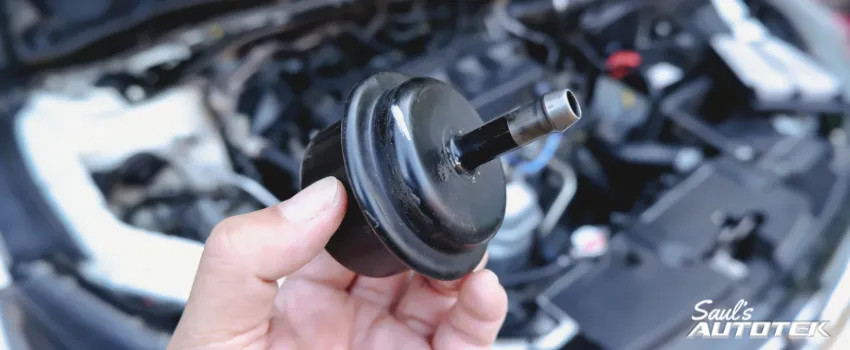Hey there. I’m Saul here at Saul’s Autotek. And today, we’re going to talk a little bit about what steers your vehicle.
Most modern vehicles are steered by their steering gearbox in pickup trucks or SUVs or by a rack and pinion assembly. Now, you’ve seen some of our other videos about rack and pinions. You’ve probably seen the one where we cut one in half out of an F-150. Today, we can’t cut this one in half but we’re going to show you a few differences that are coming out with modern technology.
In older vehicles, a rack and pinion indicates that the rack would be two set pieces of gearing with teeth along with them as a rack assembly with a pinion gear between to rotate and push them in either direction, hence the name rack and pinion. When you’re driving the car and you hold the steering wheel, you’re turning the pinion gear at the bottom end which rotates the rack. We’ve got a rack and pinion here in front of us, but it’s a little different than normal. This rack and pinion is out of a 2010 Ford Fusion Hybrid. This rack and pinion is electronically powered. So, here’s where our input would typically come out of the vehicle itself from the steering column. We’d be spinning this pinion gear and rotating it, allowing these tie rods to push in either direction based on this input. Where these gears mesh right here together, we can actually see the center bolt that holds the mesh and that’s how they align and tighten this gear set.
Now, nothing out of this seems different from a regular rack and pinion, except a standard rack and pinion in most motor vehicles is hydraulically powered. Your vehicle has a hydraulic power steering pump that runs off of the belt drive of the engine, takes a couple of horsepower away from the engine but uses that power to spin hydraulic fluid and pressurize this rack. What that’ll do is put anywhere between 300 and 1000 PSI assisting you turning the steering wheel. So when you turn that steering wheel, instead of fighting a three-, four-, or 5,000-pound car, you have up to 1000 pounds of assistance helping you push that steering wheel.
If you’ve driven an old car from the sixties or seventies that didn’t have power steering, you know what it’s like to try and turn it without that power assist. Well, in the sixties and seventies, we got power steering, and suddenly vehicles were able to turn a lot quicker and tighter. Instead of turning the steering wheel seven times, you only have to turn it two or three cases because it took less effort. So, they were able to gear it differently. By being able to turn the steering wheel-less distance keeps you safer. It means that you have to turn it a smaller amount of time and that saves you time on the road that you would otherwise be reacting to whatever’s in front of you.
Now, the reason we’re showing this electronic rack is twofold. One aspect of this racking pinion is it utilizes a collision sensor right here on the actual pinion gear itself. Now, this sensor’s job is to notice if this rotates out of specification from what the wheel speed sensors at either of the wheels are reading. As your vehicle travels down the road, all four wheels have a speed sensor that measures how fast they’re rotating. Your vehicle uses that information to determine things like your ABS or your vehicle stability control and make them work appropriately. It also is able to see if one wheel is rotating faster than the other, how large of a curve the vehicle might be making, and it uses that information in addition to this steering angle sensor in order to calculate if the vehicle is sliding or skidding and use that to protect you in the event of a crash.
So this little sensor on this modern rack and pinion might save your bacon in the event of you sliding out in the snow or the rain or some other inclement weather. One other aspect we’re going to show you about this is, down here on this end of the rack, we have this big can bolted to the side of it. Now, some of you that have any automotive knowledge, you might recognize this as almost looking like a starter motor and that’s 100% accurate. Inside this housing is a starter motor. It has a solenoid right here that engages this motor to rotate in either direction.
The motor rotates in either direction and that actually changes the direction of the gear. When this motor rotates and spins this gear, it turns a gear on the rack which physically locates it side to side. The reason we’re talking about this is that electronic power steering is coming you a vehicle near you. If your vehicle doesn’t already have an electronic power steering system, your next replacement vehicle more than likely will.
In the case of this 2010 Ford Fusion Hybrid, it was offered with an electric power steering so that the vehicle would not need that hydraulic draw away from the engine. Now, the vehicle still has a gasoline engine, but they want to use all the power from that gasoline engine as efficiently as possible. That means using electronics components for the power steering and using electronic components for the air conditioning, which you’ll see in another video we’re going to do here soon.
The reality, though, is hydraulic power steering systems are a thing of the past. You have a pump that can leak and fail. You have steering lines, two or three of them, that can lead to failure. And you have a hydraulic rack and pinion that has seals in it that can leak and fail. Modern electronic rack and pinions, no pump, no lines, no fluid, no seals. They’ve eliminated several points of failure to make a better product to keep you on the road.
So while this fits a hybrid vehicle as one of the first vehicles with the true electronic power steering system, many modern vehicles are now being equipped with these. Many General Motors, Chevy, Ford, Dodge vehicles in front-wheel-drive setups have these electronic rack and pinions. Several Toyota vehicles, such as Camrys, Corollas, or RAV4s are also equipped with electronic rack and pinions.
If you’ve got a concern about your power steering, you just want to know more about these or you really just want to understand how to keep yours alive and keep it intact as long as possible, give us a shout here at Saul’s Auto Tech, because the one thing they won’t tell you is replacing these racks cost twice as much money as replacing mechanical or hydraulic ones. Scary.
So while the automotive engineers have done everything in their power to simplify the system so that they’ve eliminated points of failure from the vehicle to make a more reliable car for you, the consumer, the result, unfortunately, is that when it does come time for the repair, that repair can be substantially cost-prohibitive. Come and see us here at Saul’s Autotek in Denver, Colorado. We’d love to talk to you about yours, show you a few tips and tricks to keep yours on the road longer and make sure that you don’t got to come in and get one of these taken care of. The last piece we’ll leave you with is this 2010 Ford Fusion, the owner’s not going to pay a penny. This is a recall item, and we’re going to make Ford take care of it for him. We’ve got your back 100%.
Schedule Your FREE diagnostic Subaru Outback Auto Repair Upkeep and Repair Appointment
Check out Our Reviews On Yelp! And Leave A Great One For Us!
Join Our Conversation on Facebook
Explore Our Exceptional Denver Auto Repair Services
- Brake Repair Service
- Suspension Repair
- Steering Repair
- Engine Repair
- Automotive Air Conditioning and Heating Repair





